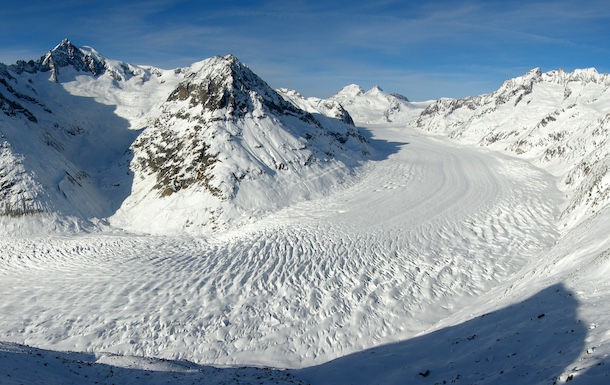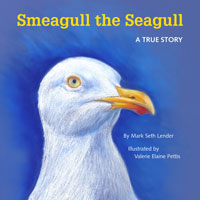Earth's Cryosphere On Thin Ice
Air Date: Week of November 14, 2025

Two memorial plaques at the bottom of the Yala Glacier in the Langtang Valley of Nepal. The glacier has lost 66% of its mass and retreated nearly 800 meters since the 1970s. (Photo: The International Centre for Integrated Mountain Development (ICIMOD))
Scientists attending the UN climate talks in Brazil are highlighting the alarming state of the cryosphere, or the frozen part of Earth covered in ice, snow, and permafrost. A recent report warns that the European Alps, Rockies of the Western U.S. and Canada, Iceland, and Scandinavia would lose nearly all ice at 2°Celsius of warming – a threshold we’re currently on track to exceed. Glaciologist and climate scientist Miriam Jackson is the Eurasia and Nordic director of the International Cryosphere Climate Initiative and joins Host Paloma Beltran to explain how the perilous state of glaciers endangers human civilization as the Earth warms.
Transcript
ONEILL: It’s Living on Earth, I’m Aynsley O’Neill.
BELTRAN: And I’m Paloma Beltran.
Scientists attending the 30th UN climate conference in Brazil are highlighting the alarming state of the cryosphere, or the frozen part of Earth covered in ice, snow, and permafrost. A recent report by the International Cryosphere Climate Initiative warns that “the European Alps, Rockies of the Western U.S. and Canada, Iceland, and Scandinavia would lose nearly all ice at 2°Celsius of warming.” And we’re on track for more than that at this point. Miriam Jackson is a glaciologist, climate scientist and the Eurasia and Nordic director of the International Cryosphere Climate Initiative. She’s there at COP30 and she joins me now. Welcome to Living on Earth, Miriam!
JACKSON: Thank you very much. Nice to be here.

A river of melt-water running down the slope of a toe of the Athabasca Glacier in Jasper National Park, Alberta, Canada. (Photo: Wikimedia Commons, Wing-Chi Poon CC BY-SA 2.5)
BELTRAN: So what is the current state of the cryosphere right now? I know you just had a presentation at COP30, at the climate talks, about the cryosphere. What are we looking at here? Where does the cryosphere stand?
JACKSON: Very good question. So yes, I've actually just been given a presentation on tropical glaciers. The tropical glaciers are the ones that, you know, these low latitudes, in Peru, in Bolivia, in Ecuador, also in Africa. They're actually responding very quickly to climate change. They're at high elevation, and they're a little bit different than other glaciers, because they sort of get mass to get snow at any time of the year, and they can melt at anytime the year. And they're changing very quickly, probably, you know, more quickly than the global average. And we do see that globally, glaciers all over the world are changing fast, some areas faster than others. For example, the European Alps, the glaciers are changing very fast in parts of Norway, especially northern Norway, on Svalbard, up, you know, very high northerly latitudes. And it's actually quite interesting because it's a little bit unusual that when there has been climate change in the past, it's possibly a little bit different from one part of the world at the other. But what we're seeing now is something very similar over the whole world, that all the different glaciers, ones that, you know, very high latitudes, almost quite close to the North Pole. The ones at very high elevation, quite close to the equator, the ones in high mountain Asia a lot of these are generally 5000 meters and above. These are all changing. Some of them are changing quite slowly, and some of them are changing quite fast. But since the turn of the century, so since 2000, many of them have lost 20% of the mass, and some of them even more, and that's a huge amount, to use that much of the mass in just over 20 years. That's not sustainable. That kind of rates many glaciers are going to disappear very soon. Some glaciers have already disappeared. Venezuela, Slovenia lost their last glaciers quite recently. So this isn't something that we're saying this is going to happen. We should be careful. This is already happening.
Miriam Jackson giving a presentation on tropical glaciers at COP30 in Belem, Brazil. Photo: Miriam Jackson)
BELTRAN: What are some of the impacts of melting glaciers on surrounding communities and on the world as a whole?
JACKSON: We're seeing many different impacts from melting glaciers. The most immediate is people, especially in high mountain areas who use the water from melting glaciers for water supply. Hindu Kush, Himalaya, a lot of people there are very dependent on glaciers for melt water, for agriculture, for hydropower, also for tourism, also for spiritual reasons, glaciers means so much to so many people. And what we're seeing is that people are already being affected by glacier change now, and this is affecting monk communities the most, affecting them now. Also affecting a lot of people downstream who might live far from the glaciers, but especially in arid regions, you know, certain parts of Central Asia and northern Pakistan, it's very dry, but they depend on water from glaciers, also water from snow and they're really seeing changes now or their going to see them very soon. Also what we're seeing is that the glaciers are also it will affect the sea level because even though the mountain glaciers are small, they're already affecting how the water goes into the sea and causes sea level rise. And this affects everybody living in coastal communities, on low lying islands.

The largest and longest glacier of the Alps: the Aletsch Glacier seen from Eggishorn, Valais, Switzerland (Photo: Tobias Alt, Wikimedia Commons,CC BY-SA 4.0)
BELTRAN: And Miriam, what are glaciologists and cryosphere researchers pushing for at COP30?
JACKSON: We're here for a few different reasons. Basically we're trying to, you know, to communicate information about the cryosphere. You know, the things I've just told you that these are the different ways the changes in glaciers are still affecting us. It's changes in water supply, it's hazards like the floods, it's sea level rise. And just trying to make sure that the negotiators understand the science that they have, they have the facts, they have the language that they need. We're working hard to get it in the text, and sometimes we do see that people in some parts of the world are thinking like why are we interested in sea ice? This doesn't affect us. You know, we're not in the Arctic, sea ice doesn't affect us. Changes in sea ice affect everybody, because this affects the albedo of the earth. As we lose sea ice, the earth gets warmer even faster. So we're trying to communicate this, that these are the facts about cryosphere, this is how fast it’s changing, this is how much the change is accelerating, and making sure that the policy makers here, the negotiators here, understand this, and they have the language also and the knowledge, so they can get this into the text, and we’ll if necessary, fight to keep it in the text, because there's always a lot of discussion on what should and shouldn't be in the text.
The Artesena glacier in Ecuador taken by Miriam Jackson during a field trip before an IPPC lead author meeting in February 2018. (Photo: Miriam Jackson)
BELTRAN: And you're currently at COP30 in Belém, Brazil, where these climate negotiations are taking place. It's been 30 years of climate negotiations. What are the sentiments there?
JACKSON: Well, the sentiments here vary quite a lot. There's many countries, you know, there's countries like Tajikistan like Nepal, like Bhutan, that are really seeing the effects now of changes in the glaciers. They might have seen deaths from these glacially outburst floods, or they might just be seeing other floods that are caused by, you know, sudden rain on the snow and they're seeing all kinds of changes, so they're very concerned.
Miriam Jackson is a glaciologist, climate scientist, the Eurasia and Nordic director of ICCI (International Cryosphere Climate Initiative) and the research scientist for the Norwegian Government at the Norwegian water sources and energy directorate. (Photo: Miriam Jackson)
And the low lying island states, you know, they have a coalition, and they're very concerned as well, because, as they say, they've contributed the least to climate change but they're some of the ones who are suffering the most, and some of these islands are very low-lying, and they're thinking, will we even still be here by the end of the century? So they really feel the urgency. There's also a lot of countries here who export oil, and burning hydrocarbons is one of the main reasons for climate change, and a lot of them are quite reluctant to see the urgency. Obviously, their countries make a lot of money from exporting oil, so they want to keep on. And I think, to be honest, I think they don't really understand that this is something that’s going to affect everyone. There's no point in continuing to make money if the whole world is struggling so much with climate change that nobody's interested in buying oil anymore, they're just interested in survival. So it is frustrating here, and for some people, this is existential. Just because of disruptions globally, we have disruptions in trade as we have more people migrating because where they live, they can no longer live, they can no longer survive. So globally, it's going to affect everybody. And it's it is very hard trying to communicate this to some of the countries who possibly aren't immediately affected, but will be in the long run. But we keep on trying.
BELTRAN: Miriam Jackson is a glaciologist, climate scientist, and the Eurasia and Nordic director of the International Cryosphere Climate Initiative. Thanks so much for joining us.
JACKSON: Thanks very much. It's been a pleasure talking to you.
Links
Learn more about the International Cryosphere Climate initiative
Living on Earth wants to hear from you!
Living on Earth
62 Calef Highway, Suite 212
Lee, NH 03861
Telephone: 617-287-4121
E-mail: comments@loe.org
Newsletter [Click here]
Donate to Living on Earth!
Living on Earth is an independent media program and relies entirely on contributions from listeners and institutions supporting public service. Please donate now to preserve an independent environmental voice.
NewsletterLiving on Earth offers a weekly delivery of the show's rundown to your mailbox. Sign up for our newsletter today!
 Sailors For The Sea: Be the change you want to sea.
Sailors For The Sea: Be the change you want to sea.
 The Grantham Foundation for the Protection of the Environment: Committed to protecting and improving the health of the global environment.
The Grantham Foundation for the Protection of the Environment: Committed to protecting and improving the health of the global environment.
 Contribute to Living on Earth and receive, as our gift to you, an archival print of one of Mark Seth Lender's extraordinary wildlife photographs. Follow the link to see Mark's current collection of photographs.
Contribute to Living on Earth and receive, as our gift to you, an archival print of one of Mark Seth Lender's extraordinary wildlife photographs. Follow the link to see Mark's current collection of photographs.
 Buy a signed copy of Mark Seth Lender's book Smeagull the Seagull & support Living on Earth
Buy a signed copy of Mark Seth Lender's book Smeagull the Seagull & support Living on Earth

